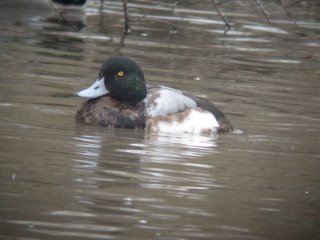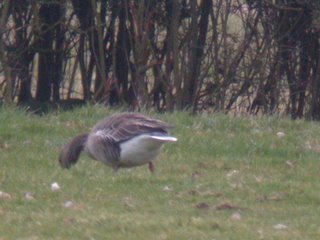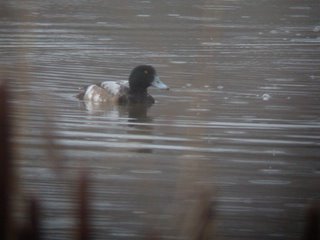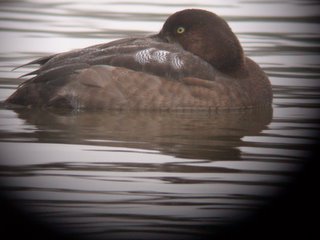15 February 2006 The waders are building up in number due to flooding of the Top New and Tack Pieces. Up to 7000
Lapwing, 1700
Golden Plover and 1000
Dunlin are back and should increase massively if the mild and wet weather lasts. We have been pumping onto these fields so make the most of the winter birding over the next few weeks as they will all be off soon. A group of four
Redshank were in company of the wintering
Spotted Redshank from the Martin Smith Hide. MJM rediscovered last week's first winter female
Greater Scaup today from the Robbie Garnett Hide and at least 11
Black-tailed Godwit and the
Ruff (no counts) were with the Lapwing. The three
'continental' Greylag were on the Top New Piece. The
Ferruginous x hybrid was on the Rushy. Single
Lesser Redpoll are seen daily at present.
14 February 2006 The female
Smew was on the South Lake and the first winter male
Greater Scaup was on the European enclosure pond. A flock of nine
Ruff on the Tack Piece included a colour marked individual, a further? 16 were seen on the Top New Piece. A
Water Vole was next to the entrance ramp rhine (ditch). The three hulking
'continental' Greylag Geese were on the Top New Piece (look out for the larger size, paler plumage and heavy bills).
12 February 2006 At least two
Little Stint were on the Dumbles. The geese came in to drink on the Tack Piece and brought an escaped (non WWT) Bar-headed Goose with them. It seems to prefer the Barnacle Geese for company. The
Dark-bellied Brent and
Pink-footed Goose were also seen. A female
Merlin raised over 2500 birds by hunting over the field in it's thrush style hunting flight, also
Kingfisher,
Water Rail and up to ten
Snipe were seen from the Martin Smith Hide and sixty on the Top New Piece.
11 February 2006 The dawn exit flight of the 800
E. White-fronted Geese was excellent due to a stunning sunrise as a backdrop. A female
Merlin dashed over the South Lake heading toward the river and an adult male
Red crested Pochard, first winter male
Greater Scaup and adult female
Smew were all present on the frozen lake. Other species seen/heard on this Breakfast with the Birds event included four
Cetti's Warblers (six on site at least) and a male
Stonechat. The
Dark-bellied Brent and
Pink-footed Goose were also seen. A
Siskin showed to less than a foot at the Peng Obs as it fed on buds. MJMcGill and JS Lees.













